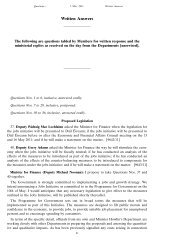Written Answers. - Parliamentary Debates - Houses of the Oireachtas
Written Answers. - Parliamentary Debates - Houses of the Oireachtas
Written Answers. - Parliamentary Debates - Houses of the Oireachtas
You also want an ePaper? Increase the reach of your titles
YUMPU automatically turns print PDFs into web optimized ePapers that Google loves.
Questions— 14 February 2012. <strong>Written</strong> <strong>Answers</strong><br />
form, its suitability and ease <strong>of</strong> completion. It is Revenue’s intention to complete <strong>the</strong> consultation<br />
process as quickly as possible and to have <strong>the</strong> Form 12S available for completion as a<br />
matter <strong>of</strong> urgency.<br />
141. Deputy Pat Deering asked <strong>the</strong> Minister for Finance if he will consider a special higher<br />
tax rate for those in receipt <strong>of</strong> retirement packages greater than €200,000.00. [7609/12]<br />
Minister for Finance (Deputy Michael Noonan): It is not clear from <strong>the</strong> question whe<strong>the</strong>r<br />
<strong>the</strong> Deputy’s reference to “retirement packages” is to retirement lump sums or to <strong>the</strong> combination<br />
<strong>of</strong> lump sum and pension. An individual in receipt <strong>of</strong> pension income is liable to tax on<br />
that income at his or her marginal rate <strong>of</strong> income tax. I have no plans to change <strong>the</strong>se arrangements.<br />
I am informed by <strong>the</strong> Revenue Commissioners that two separate tax treatments can<br />
apply to lump sum payments depending on <strong>the</strong> nature <strong>of</strong> <strong>the</strong> lump sums paid to a retiring<br />
individual. (These rules apply equally to all employees — public and private sectors). The<br />
details <strong>of</strong> <strong>the</strong>se treatments are set out hereunder. It should be noted that <strong>the</strong> lifetime limits on<br />
<strong>the</strong> amounts <strong>of</strong> lump sums that can be paid tax-free under pension arrangements or as termination<br />
payments were reduced to €200,000 in last year’s Finance Act. I have no plans for fur<strong>the</strong>r<br />
changes in this area at this time.<br />
Retirement lump sums paid under pension arrangements<br />
The following arrangements apply to retirement lump sums paid under Revenue approved<br />
pension arrangements:<br />
• Lump sum amounts up to €200,000 are paid free <strong>of</strong> tax. They are also paid free <strong>of</strong><br />
Universal Social Charge (USC).<br />
• The portion <strong>of</strong> a lump sum between €200,001 and €575,000 is taxed on a ring-fenced<br />
basis at 20%. (This means that no tax credits or o<strong>the</strong>r tax reliefs can be set against<br />
this portion <strong>of</strong> <strong>the</strong> lump sum.) No USC is chargeable.<br />
• Any amount <strong>of</strong> a lump sum in excess <strong>of</strong> €575,000 is taxed at <strong>the</strong> individual’s marginal<br />
rate <strong>of</strong> tax (credits and o<strong>the</strong>r tax reliefs are available). In this instance, USC is chargeable<br />
on <strong>the</strong> excess.<br />
These amounts are lifetime amounts with prior lump sums aggregating with later lump sums.<br />
Termination lump sums<br />
Section 201 <strong>of</strong> <strong>the</strong> Taxes Consolidation Act 1997 and Schedule 3 to that Act set out <strong>the</strong><br />
legislation in relation to <strong>the</strong> exemptions that apply to ex-gratia payments including retirement<br />
gratuities, and <strong>the</strong> taxation <strong>of</strong> any balance after applying <strong>the</strong>se exemptions. The same rules<br />
apply to all employees and <strong>of</strong>fice holders in receipt <strong>of</strong> ex-gratia payments.<br />
Statutory redundancy payments are exempt from income tax. In addition, <strong>the</strong>re are<br />
additional exemption limits for ex-gratia redundancy payments or retirement gratuities in<br />
excess <strong>of</strong> <strong>the</strong> statutory redundancy amount, namely—<br />
• a basic exemption <strong>of</strong> €10,160 plus €765 per complete year <strong>of</strong> actual service in excess<br />
<strong>of</strong> <strong>the</strong> statutory redundancy payment;<br />
Or<br />
• Standard Capital Superannuation Benefit i.e. 1/15th <strong>of</strong> <strong>the</strong> person’s annual income<br />
(average <strong>of</strong> <strong>the</strong> last three years) for each year <strong>of</strong> employment less any tax-free lump<br />
sum which is received or receivable under any approved or statutory pension scheme.<br />
It is open to <strong>the</strong> taxpayer to choose whichever relief is <strong>of</strong> most benefit.<br />
365


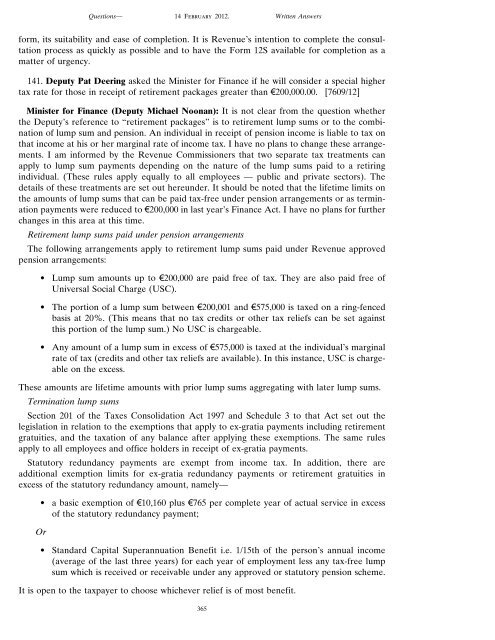

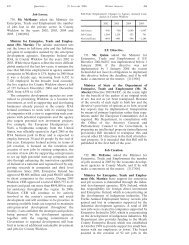

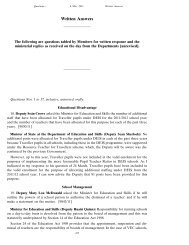

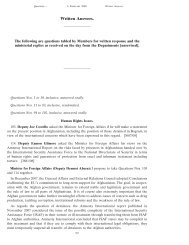


![[Deputy Michael Noonan.]](https://img.yumpu.com/30494839/1/190x245/deputy-michael-noonan.jpg?quality=85)
